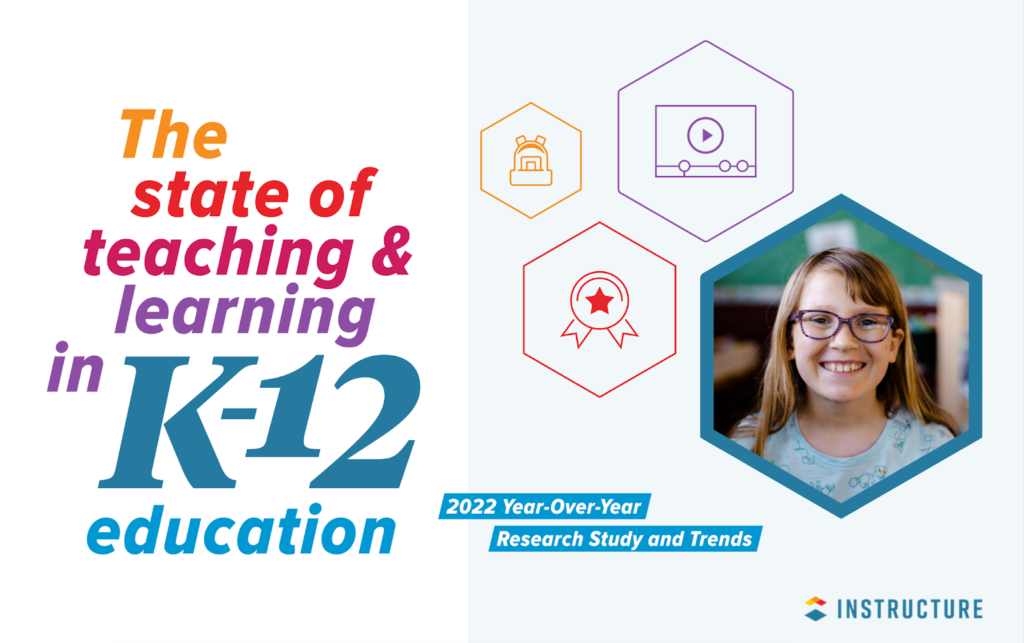The State of Teaching and Learning in K-12 Education
Key Points
-
Recently, Instructure shared the results from their research study which focused on the state of teaching and learning in K through 12 education.
-
The study looked at the different trends and changes in education over the past two years.
-
The report provides insight into some of the challenges faced by educators, six big trends noticed and some takeaways and lessons that have been learned.

Recently, Instructure shared the results from their research study which focused on the state of teaching and learning in K through 12 education. The study looked at the different trends and changes in education over the past two years. The report provides insight into some of the challenges faced by educators, six big trends noticed and some takeaways and lessons that have been learned.
To gather data, they surveyed nearly 1,400 parents of students in grades K through 12 as well as administrators and teachers across the United States. In the 2021 survey, 70% of the 665 respondents were parents. In 2022, they had double the number of respondents and half the number of parents, 34%, who responded to the survey.
The goals were to determine what areas were successful and which practices and tools promoted engagement. Respondents were also asked about their perspectives on how COVID might continue to impact the learning experience. The report looked at the impact of Covid on teaching and learning and what that means for the future. This report provides a lot of information for educators as well as for parents interested in learning more about the types of changes that took place as a result of the pandemic.
Pre-covid resistance to bringing in the tech
We’ve been working towards implementing technology and different methods into our classrooms for many years, with the goal of helping students to develop essential “21st-century skills.” While there are many methods and digital tools available, it can be difficult to decide where to begin. Considering what would have the biggest impact on students, what might provide the most for educators and which are applicable regardless of specific grade level or content area taught.
For all educators, the shift to remote learning was difficult, regardless of comfort with tech use. However, for some educators, the sudden shift was extra challenging because of inexperience with or resistance to using tech pre-covid. With these challenges, came a lot of positive results. According to the study, it started as “an unplanned shift to remote learning” and has now “grown into a movement minus a transformation, that has led teachers and educators to look at how they are being intentional about designing a digital learning experience in their classroom.”
Making the choices
Educators, at the start, were just trying to make it through. To assist, many edtech companies offered their products for free. While this was well-received, it also led to bringing tech in without a lot of purposefulness and also led to overwhelm for teachers, students and families. With technology, we need to consider the purpose and continue to evaluate the benefits. This study looked at some common questions regarding learning:
What does success look like for k-12 students?
What factors tie into and boost student engagement?
How does technology fit into all of this and how does it impact student engagement? How is covid continuing to impact students and educators when it comes to learning? What have we learned from this and where are we going next?
The findings
All stakeholders including administrators, parents, and teachers believe that two key focus areas are student engagement and student attendance, even if that means in the virtual space. Covid is still impacting a lot of things when it comes to education. Whether due to absences because of Covid, students lacking motivation or not feeling as engaged in learning, all led to a decrease in academic achievement. Teachers have a lot on their minds to determine how to increase student attendance and engage them more in the classroom. Without a doubt, there are a lot of methods and no shortage of digital tools available for use in the classroom.
Emphasis was placed on being mindful and purposeful in the choices that we make. A few areas related to technology were balancing the types of tools being used and focusing on how technology enhances learning. And more importantly, there needs to be support. One, working together with parents to help students to stay engaged, and two, school districts must support teachers, especially in the implementation of technology and providing high-quality instruction.
Six key trends
There were six key trends that parents and educators found to be the most important.
1. High-quality teaching is essential to have high-quality learning. Students need to have access to immersive and experiential learning experiences given by teachers who feel prepared because they’ve had the right professional development.
2. Student engagement is always an issue and finding the best ways to focus on building student engagement and providing personalized starting for students are key.
3. Look at the frequency and impact of assessments, especially standardized testing which is high-stakes assessment. These place burdens on students and teachers. So much testing happens at the end of the year which can deplete student engagement and motivation.
4. Hybrid and digital learning are here to stay and I think that’s a good thing. Being able to offer options for students depending on challenges experienced in the world, changes in our school system, or when students just may not be able to be in the class due to events happening in their lives or due to illness for example. But because we know that we will still need to have the hybrid and digital options available, teachers need to be prepared and we have to make sure that there are ways that we can stay connected.
5. Equity must always be a focus. I believe this is something that should be higher on the list. There have been improvements in access to devices and being able to use the tools and resources at home. This must remain a priority for all schools especially when it comes to funding for resources and devices for students and teachers to use and also making sure that families can access these resources at home, to truly support the home to school community.
6. Tech is here to stay. ”Technology is no longer a nice to have, it is essential to k-12 pedagogy.” I believe this one absolutely because of what technology has enabled us to do over the past two years. As we’ve struggled to shift between in-person, hybrid and virtual learning environments, technology is not the only answer. However, it can facilitate methods and create communities that enable us to build relationships when we are unable to do so in the physical space.
The biggest initial challenge was access.
Rachelle Dené Poth
Elements leading to student success
Parents were asked about how important the core educational elements are to student success. The top five results included instruction from high-quality teachers, high performance in core courses, participation in individualized programs, GPA, and participation in college readiness programs. Comparing between 2021 and 2022, most of the numbers stayed quite close, however for GPA, 75% of parents found that to be a top priority whereas in 2022 that decreased to 66%. The college readiness program participation in 2021 was at 71% and it dropped by 8% in 2022. What this tells me is that parents and educators are recognizing that the GPA and college readiness are not necessarily the most important. Having access to high-quality instruction from teachers and participation in individualized programs are essential, and these results stayed nearly the same across both years.
One of the solutions presented from the perspective of Instructure is that in order for students to be successful, teachers need to be successful. This means that they have to have access to ongoing professional development, administrator support and be able to choose areas where they believe they need to grow. When we talk about motivation, autonomy, mastery, and purpose, in alignment with Daniel Pink in his book Drive, are essential for meaningful learning. When given a choice, teachers will try to find something that they believe will be most beneficial for their own professional growth and which will directly impact the students or the colleagues that they are working with. To have high-quality instruction, schools need to provide the right PD and there needs to be equitable access to meaningful PD.
In the study, student engagement was considered to be the number one measure of success and educators saw that engagement 94% and attendance 91% are the most important metrics to look at to determine student success. From 2021 to 2022 areas that increased were student engagement, student attendance, academic achievement, and student graduation rate, which were areas that those who responded believed define student success.
Challenges with educational experiences
The biggest initial challenge was access. Schools were made aware of a lack of devices or lack of access to reliable internet for students and families to be able to connect and communicate with teachers and get the help and the resources when they needed it. We cannot provide equal access to digital learning unless students have access to the right devices and reliable internet. The key is the equitable access to quality content and instruction, that should be “delivering the flexibility to allow students to progress via time or mastery” and using tools that integrate with an LMS or other learning tools which helps to decrease the amount of overwhelm that students and family supporting them might experience. Another factor was the economic divide. High-income households reported 77% satisfaction rate with the quality of the teacher whereas low-income reported 66% satisfaction with access to the equipment. This is definitely something that we need to focus on.
Assessments were also a challenge. We need to consider the purpose of the assessment, the objective, if there are multiple ways for students to show learning, and what is the data that we are receiving. We must be flexible because one size does not fit all when it comes to student assessment. We want students to have equitable access and opportunities to share what they have learned. Whether that means bringing in different methods, providing multiple modalities and using different tech tools, a focus on building relationships and understanding student needs and interests are essential so that we can provide better options for students.
The study stated that assessment “should be viewed as a tool for guiding further instruction and evaluating how teachers can improve their own instructional practice. When we have access to immediate assessment feedback, it helps us to better deliver our instruction and to adapt and adjust and provide exactly what every one of our students needs.”
Why we need technology
Technology has been said to “level the playing field,” because it enables teachers to create individual learning paths or provide differentiation. Even if students or teachers are hesitant to use technology, almost all tools offer something for everyone. Depending on how it is used, the “why” can amplify learning, boost student engagement, facilitate more connections and help students to build skills beyond the content area. After the experience we’ve had in the last two years, 58% of educators are more positive towards online learning than prior to Covid. 83% of educators believe technology will continue to increase in importance when it comes to teaching, learning and preparing students for the future.
In summary, hybrid and digital teaching and learning are here to stay. According to a Gartner study, it is predicted that by the end of the year 2025, “90% of US public school districts will be leveraging a combination of in-person and digital remote learning for both regular and ongoing instruction.” The use of technology can help educators provide greater personalized instruction or opportunities for students to engage in self-paced learning, all of which will help to focus on essential SEL skills, and be best prepared for today and the future.








Nadia Rolle
Excellent read! I have one question - as accessibility improves, what measures are being considered to encourage accountability and honesty by students, especially in a fully virtual setting?
Amy Saunders
Hmm.. somehow I feel like you highlighted a good point there by saying that with the right teaching methods we'd be able to maintain the level of focus among students in the long run. My former neighbor, a K-12 teacher, just moved to New York and his new workplace is filled with kids who are quite difficult to handle. I'll recommend this alternative to him so he could carry out his daily tasks easily. http://truenorthk12.com/